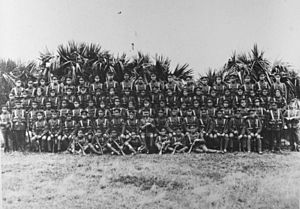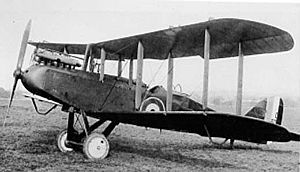Arthur Spurling facts for kids
Quick facts for kids
Arthur Spurling
|
|
|---|---|
| Born | 19 May 1896 Bermuda |
| Died | 1984 Surrey, England |
| Allegiance | United Kingdom |
| Service/ |
British Army |
| Years of service | 1915–1919 1939–1945 |
| Rank | Squadron Leader |
| Unit | Bermuda Volunteer Rifle Corps Lincolnshire Regiment No. 49 Squadron RAF |
| Battles/wars | First World War |
| Awards | Distinguished Flying Cross |
Arthur Rowe Spurling (born May 19, 1896 – died 1984) was a brave soldier and pilot from Bermuda. He fought in the First World War as an infantryman and later became a skilled pilot. He was known as a "flying ace" because he shot down six enemy planes. He also helped during the Second World War by flying planes across the ocean.
Contents
Early Life and Joining the War
Arthur Spurling was born in Hamilton, Bermuda, on May 19, 1896. His family was well-known in Bermuda.
When the United Kingdom declared war in August 1914, volunteer army groups in Bermuda got ready to help. These groups included the Bermuda Volunteer Rifle Corps (BVRC). Even though they were needed in Bermuda, they wanted to send soldiers to the war in Europe.
Arthur Spurling joined the BVRC in February 1915. He trained with other volunteers at Warwick Camp in Bermuda.
Fighting in France
On May 7, 1915, Arthur and 88 other soldiers left Bermuda for England. They hoped to join the Second Battalion of The Lincolnshire Regiment, which had been in Bermuda before the war.
When they arrived, the Second Battalion was already fighting in France. So, Arthur's group joined the First Battalion of the Lincolns instead. They were the first volunteer unit from a British colony to reach the front lines.
Arthur Spurling was wounded twice in 1916. First, he was hurt in the hand in July. A few days later, he was wounded in the foot and even reported being "buried for a few hours" by an explosion.
Becoming a Pilot
In July 1917, Arthur Spurling became an officer in the Royal Flying Corps (RFC). This was the air force of the British Army at the time. He was one of sixteen soldiers from his Bermuda unit who became officers during the war.
Arthur trained to be a pilot at Hendon Aerodrome. In July 1918, he joined No. 49 Squadron RAF. He flew a plane called the Airco DH.9, which was a light bomber. This plane had two people: a pilot and an observer who also acted as a gunner.
By this time, the RFC had joined with another air service to create the independent Royal Air Force (RAF) on April 1, 1918. So, Arthur became part of the new RAF.
A Flying Ace
On August 23, 1918, Arthur Spurling was returning from a bombing mission. He got separated from his group. He thought he was over friendly lines and started to land at what he thought was his own airfield. But it was actually a German airfield!
Suddenly, a German Fokker D.VII fighter plane attacked him. Then he saw about thirty more German planes. Even though he was flying a bomber and was greatly outnumbered, Arthur was incredibly brave. He flew right through the middle of the enemy planes.
- He shot down one plane, which burst into flames.
- Two other planes spun out of control, and one crashed.
- Five more enemy planes then attacked him. But Arthur flew his plane so skillfully that his observer, Sergeant Frank Bell, was able to shoot down two of them in flames.
These five victories in one day made Arthur Spurling an "ace in a day." A "flying ace" is a pilot who has shot down five or more enemy aircraft. For his amazing bravery, Arthur was given the Distinguished Flying Cross. Sergeant Bell also received an award called the Distinguished Flying Medal.
Just two days later, Arthur shot down another German plane. This brought his total victories to six, making him a true flying ace.
Second World War Service
After the First World War, Arthur Spurling returned to his normal life in Bermuda. But when the Second World War began, he rejoined the RAF. He became a Squadron Leader.
He worked in RAF Transport Command, which was in charge of flying cargo and people across the Atlantic Ocean. Bermuda was an important stop for these flights. During this war, Arthur was even credited with helping to identify a spy in Canada.
Later Life
After the Second World War, Arthur Spurling went back to civilian life. He married Ilys Darrell in 1948. He owned a taxi company and a paint company called Rowe Spurling Paint Company Ltd, which still exists today.
In the 1970s, Arthur and Ilys moved to Guernsey. They planned to return to Bermuda, but Arthur became ill. He passed away in a nursing home in England in 1984. His body was brought back to Bermuda for his funeral and he is buried in Pembroke Parish.
Images for kids





